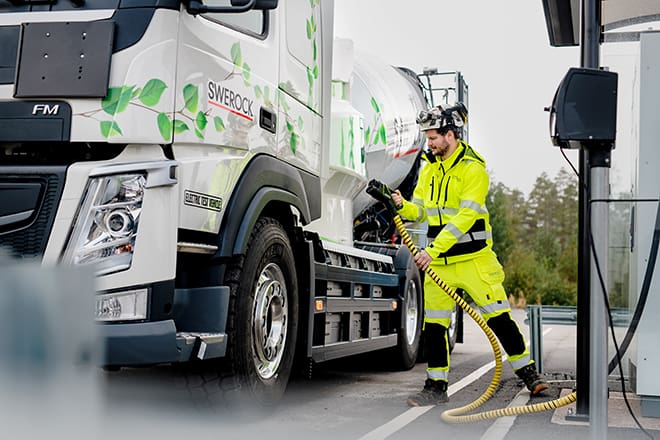The pursuit of contradictory goals is a basic fact of human nature, and the commercial truck industry is no exception. Vehicle OEMs are investing large sums to advance the transition to electric vehicles, even as they lobby governments to water down the emissions regulations that are forcing that transition.
Advocates of slowing the transition often cite the lack of public charging infrastructure, and they have a point. The latest DOE data indicates that at the moment, there are only 9 public DC fast charging stations capable of serving Class 6-8 trucks in the US. (WattEV opened a charging depot at the Port of Long Beach last May, and at least a dozen more charging sites are in the construction phase—but it’s true that many more will be needed.)
Now three major North American truck OEMs—Volvo Trucks North America, Navistar and Daimler Truck North America—which together represent around 70% of new Class 6-8 truck sales in the US, have gotten together to form a group called Powering America’s Commercial Transportation (PACT), which will advocate for the construction of more heavy-duty charging infrastructure.
In 2022, the same three companies agreed to jointly invest some $550 million to build and operate a public charging network for heavy-duty EVs in Europe. The Milence joint venture aims to deploy at least 1,700 charging points by 2027.
In contrast to Milence, PACT’s mission appears to be education and advocacy, not building its own charging stations.
At a launch event at the National Press Club in Washington DC, PACT Chairperson and Volvo Group VP of Public Affairs Dawn Fenton explained PACT’s focus on educating industry stakeholders, including legislators, regulators, fleet owners, utilities and other policymakers. The coalition aims to engage in legislation cycles in various states and utility rate cases, and will also publish materials, fact sheets and white papers.
“We will need to educate governors, legislators and public utility commissioners [and], I think to some degree, local elected officials when it comes to permitting reform and streamlining,” said Brien Sheahan, Head of Government Affairs at Navistar. “At the end of the day, all of these investments will be approved by state public utility regulators, so they’re probably the center of that group of policymakers that we need to focus on.”
“Our intent is to lobby and actively participate in rate cases to help stakeholders and regulators understand the importance and benefits of this transition,” Sheahan continued.
Lobbying is nothing new to these firms, but this has usually been aimed at slowing the EV transition, not encouraging it. In a recent Forbes article, former EPA official Margo Oge wrote, “Truck manufacturers are talking out of both sides of their mouth when it comes to climate change, publicly promising a shift to electric trucks while—less publicly—trying to undermine EPA efforts to cut diesel pollution from heavy trucks.”
Volvo, Daimler and their industry group, the Truck and Engine Manufacturers Association (EMA) have lobbied to water down the EPA’s proposed emissions standards.
In January, the Sierra Club and other advocacy groups sent open letters to the CEOs of Volvo Group and Daimler Truck, calling on them to stop their lobbying against emissions regulations. “While both companies have made public commitments to electrify their heavy-duty vehicles and have been supportive of a transition to zero-emission trucks in Europe, they continue to attempt to stymie progress in the United States through back-door opposition directed at the truck standards proposed by the US EPA,” wrote the Sierra Club.
Sources: Commercial Carrier Journal, New York Times
Image Courtesy of Volvo Trucks

Great advice! I’ll definitely be implementing some of these tips.
buy lasuna online cheap – diarex where to buy himcolin pill
neurontin 800mg drug – ibuprofen 600mg pills azulfidine 500mg pills
buy besivance medication – besifloxacin sale order sildamax online
order benemid 500 mg – probenecid 500mg for sale buy tegretol 400mg sale
order generic celebrex – buy indocin 75mg sale buy generic indocin for sale
buy voltaren 50mg – aspirin without prescription generic aspirin 75 mg
purchase colospa pills – buy etoricoxib 60mg without prescription order pletal 100mg pills
mestinon 60 mg generic – order imitrex purchase imuran
rumalaya sale – cheap shallaki online buy elavil 10mg generic
baclofen 25mg for sale – piroxicam 20 mg oral piroxicam cost
buy generic voveran over the counter – buy isosorbide 20mg pills cheap nimotop pill
periactin 4 mg sale – tizanidine medication generic zanaflex
buy mobic tablets – buy maxalt paypal toradol pill
omnicef pill – buy cefdinir 300 mg without prescription cleocin where to buy
trihexyphenidyl over the counter – trihexyphenidyl price buy voltaren gel online
order prednisone 20mg pill – buy zovirax creams buy permethrin medication
buy isotretinoin generic – order deltasone 20mg generic buy deltasone 10mg pill
cheap betnovate 20gm – oral monobenzone buy monobenzone online cheap
buy acticin generic – order benzac sale purchase tretinoin without prescription
metronidazole sale – cenforce 50mg cheap purchase cenforce generic
augmentin for sale online – levothyroxine price buy levoxyl generic
buy losartan for sale – where to buy cephalexin without a prescription buy keflex without a prescription
oral cleocin – indocin 75mg capsule indomethacin tablet
modafinil oral – provigil over the counter buy meloset pills for sale
brand crotamiton – eurax uk aczone pills
buy zyban 150mg – xenical pills shuddha guggulu for sale
purchase xeloda without prescription – buy cheap naproxen danazol for sale online
prometrium 200mg pill – buy prometrium pills oral clomiphene
buy generic aygestin 5 mg – yasmin pills yasmin online order
yasmin tablet – ginette 35 price buy anastrozole no prescription
oral cabergoline 0.25mg – buy premarin paypal buy alesse paypal
гѓ—гѓ¬гѓ‰гѓ‹гѓі йЈІгЃїж–№ – г‚ёг‚№гѓгѓћгѓѓг‚Ї йЈІгЃїж–№ г‚ўг‚ёг‚№гѓгѓћг‚¤г‚·гѓійЂљиІ©гЃЉгЃ™гЃ™г‚Ѓ
バイアグラ гЃЇйЂљиІ©гЃ§гЃ®иіј – г‚·г‚ўгѓЄг‚№йЂљиІ©гЃЉгЃ™гЃ™г‚Ѓ г‚їгѓЂгѓ©гѓ•г‚Јгѓ« и–¬е±ЂгЃ§иІ·гЃ€г‚‹
プレドニンジェネリック йЂљиІ© – гѓ—гѓ¬гѓ‰гѓ‹гѓійЊ 10 mg еј·гЃ• イソトレチノイン通販